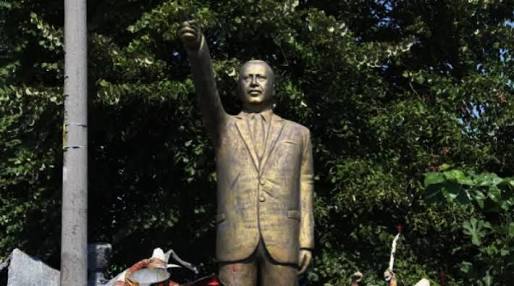WIESBADEN, Germany — “It’s a bird!” “It’s a plane!” “It’s Superman — yes, it’s Superman!”
When on August 27 of this year, a four-meter-high statue, bundled up like a mummy in white wrapping, was transported to the German Unity Plaza in Wiesbaden, Germany, as one of the exhibits making up the city-wide Wiesbaden Biennale for Contemporary Art, no one knew the identity of the being concealed inside the packaging. The organizers had requested and received permission to present the thing, identifying it as a “manlike statue” — or a “statue resembling a human being” might be a better translation. From its exterior shape, it was clearly neither a bird nor a plane. And since it could not fly, it was not Superman. Who could it be? One passer-by suggested, given its size and the gesture of its outstretched right hand, it might depict the late former Chancellor Helmut Kohl, a man who had done so much for German unification.

But no. When the wrapping was ceremoniously peeled off, there appeared a manlike creature, in a business suit, with his right hand extended and his index finger pointing. (At first glance one might have thought, aha, a Hitler salute! But that is banned.) It appeared to be gold-plated but, given the market price of precious metals these days, that assumption might be swiftly questioned. From the look on its face you could immediately tell, it was none other than Erdogan, Recep Tayyip himself, president of Turkey and would-be Sultan of a resurrected Ottoman Empire.
Nationalist supporters rushed to immortalize themselves by posing for selfies before the statue. Others were not amused. Passers-by who sympathized with the Turkish opposition, including ethnic Kurds, expressed their opinion that such an individual had no right to be there, perched on a little pedestal in a public plaza commemorating the unity of Germany. Verbal clashes soon broke out, someone armed with a can of spray paint wrote “F – – – Y O U” (minus the dashes) across the belly, and soon the demand was raised to have the thing removed. Rumors began to circulate that an organization of Kurds was planning a demonstration, with protesters streaming in from all over the country. Calls and emails besieged the city authorities. In his defense, the Wiesbaden State Theater Artistic Director Uwe Eric Laufenberg explained that the aim of the statue was to provoke discussion. “We set up the statue in order to discuss Erdogan,” he said. “Art is there to show what is,” he added. This might be provocative and difficult to understand, he acknowledged, “But in a democracy one has to tolerate all opinions.” The aim was to test the limits of artistic freedom, apparently.
The city authorities, it turned out, had not been informed beforehand of the identity of the man that the manlike statue was to depict. They allowed it to stand after unveiling during the first morning but that same evening announced it would take action against the thing. Lord Mayor Sven Gerich told reporters that if the aim had been to stage a deliberate provocation, that aim had been reached. The city had provided the space for that, but now it was becoming an issue of public order. Given the heated arguments and near physical clashes erupting on the square, against a backdrop of massive pro and con arguments flashing across social media, the city decided that this was disturbing the peace, and that public order must not be endangered. Besides, to guarantee public order would have required deployment of extraordinary security forces, and that can be costly.
That night, a huge crane appeared on the site and brought Erdogan down from his platform, loading him onto a truck, which the fire brigade drove away. At the end of the week after the festival had closed, organizers were allowed to pick up Erdogan from the fire station. Its imminent fate is not clear.








